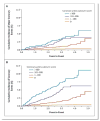Providing Evidence for Subclinical CVD in Risk Assessment
- PMID: 27741975
- PMCID: PMC5117817
- DOI: 10.1016/j.gheart.2016.08.003
Providing Evidence for Subclinical CVD in Risk Assessment
Abstract
When the MESA (Multi-Ethnic Study of Atherosclerosis) began, the Framingham risk score was the preferred tool for 10-year global coronary heart disease risk assessment; however, the Framingham risk score had limitations including derivation in a homogenous population lacking racial and ethnic diversity and exclusive reliance on traditional risk factors without consideration of most subclinical disease measures. MESA was designed to study the prognostic value of subclinical atherosclerosis and other risk markers in a multiethnic population. In a series of landmark publications, MESA demonstrated that measures of subclinical cardiovascular disease add significant prognostic value to the traditional Framingham risk variables. In head-to-head studies comparing these markers, MESA established that the coronary artery calcium score may be the single best predictor of coronary heart disease risk. Results from MESA have directly influenced recent prevention guidelines including the recommendations on risk assessment and cholesterol-lowering therapy. The MESA study has published its own risk score, which allows for the calculation of 10-year risk of coronary heart disease before and after knowledge of a coronary artery calcium score.
Copyright © 2016 World Heart Federation (Geneva). Published by Elsevier B.V. All rights reserved.
Conflict of interest statement
There are conflicts of interest for this paper for any author.
Figures






References
-
- Dawber TR, Kannel WB, Lyell LP. AN APPROACH TO LONGITUDINAL STUDIES IN A COMMUNITY: THE FRAMINGHAM STUDY. Ann N Y Acad Sci. 2006;107:539–56. - PubMed
-
- Wilson PW, D’Agostino RB, Levy D, Belanger AM, Silbershatz H, Kannel WB. Prediction of coronary heart disease using risk factor categories. Circulation. 1998;97:1837–47. - PubMed
-
- Executive Summary of The Third Report of The National Cholesterol Education Program (NCEP) Expert Panel on Detection, Evaluation, And Treatment of High Blood Cholesterol In Adults (Adult Treatment Panel III) JAMA. 2001;285:2486–97. - PubMed
-
- Bild DE, Bluemke DA, Burke GL, et al. Multi-ethnic study of atherosclerosis: objectives and design. Am J Epidemiol. 2002;156:871–81. - PubMed
Publication types
MeSH terms
Substances
Grants and funding
- HHSN263201500003I/NH/NIH HHS/United States
- R21 DA024273/DA/NIDA NIH HHS/United States
- R01 HL096875/HL/NHLBI NIH HHS/United States
- R01 HL074406/HL/NHLBI NIH HHS/United States
- R01 HL066075/HL/NHLBI NIH HHS/United States
- R01 HL088451/HL/NHLBI NIH HHS/United States
- R01 HL074338/HL/NHLBI NIH HHS/United States
- R01 HL077449/HL/NHLBI NIH HHS/United States
- R01 HL077612/HL/NHLBI NIH HHS/United States
- R01 DK080015/DK/NIDDK NIH HHS/United States
- RC1 HL100543/HL/NHLBI NIH HHS/United States
- R01 HL093081/HL/NHLBI NIH HHS/United States
- R21 HL091217/HL/NHLBI NIH HHS/United States
- R01 HL098077/HL/NHLBI NIH HHS/United States
- R01 HL076831/HL/NHLBI NIH HHS/United States
- UL1 TR001079/TR/NCATS NIH HHS/United States
- R21 HL109924/HL/NHLBI NIH HHS/United States
- N01 HC095162/HL/NHLBI NIH HHS/United States
- R01 HL086719/HL/NHLBI NIH HHS/United States
- UL1 TR000040/TR/NCATS NIH HHS/United States
LinkOut - more resources
Full Text Sources
Other Literature Sources

